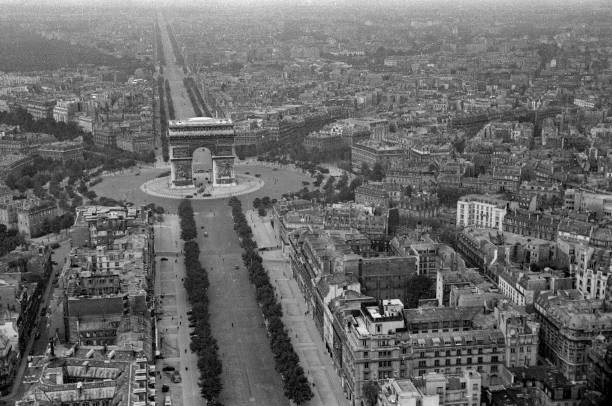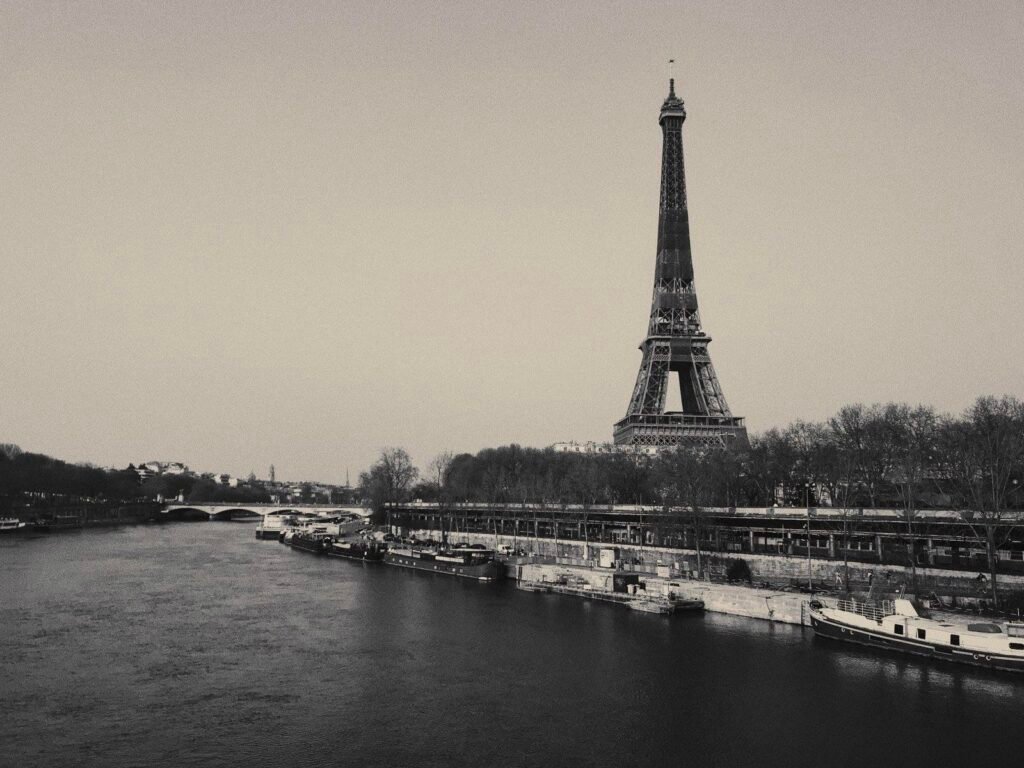Paris Then and Now
Paris Then
Paris, the capital of France, is located in the north-central region of the country and has a rich historical background that dates back to ancient times.
The city’s origins can be traced to the ancient oppidum of the Parisii, a Gallic tribe, which was first mentioned by Julius Caesar in the 1st century BC as “Lutetia of the Parisii.”
The name Paris evolved over time, with early references such as “Lutecia” during the Roman era and “Paris” by the 13th century.
The name itself is believed to be derived from the Parisii tribe, though its exact meaning remains a topic of scholarly debate. Various interpretations suggest it could relate to terms for “cauldron,” “commanders,” or “spear people,” reflecting the tribe’s cultural and linguistic connections.
The city’s modern name, Paris, has no link to the Paris of Greek mythology, despite some superficial similarities.

Over time, residents of Paris, known as Parisians in English and Parisiens in French, have shaped the city into the cultural and political heart of France, with its rich heritage evident in its monuments, language, and traditions.
Related Article: London Then and Now
Paris History
The history of Paris, one of the world’s most iconic cities, spans millennia, beginning with evidence of human habitation around 7600 BCE.
By the end of the 3rd century BCE, the Gallic tribe of the Parisii had established a settlement on the Île de la Cité, which became known as Lutetia.
The name was later Latinized as “Midwater-Dwelling,” reflecting the city’s location along the Seine River.
Under Roman influence, Lutetia grew into a prosperous town, characterized by Roman infrastructure such as baths, a forum, and an amphitheatre.
Related Article: Phnom Penh Then and Now
During the barbarian invasions of the 2nd century CE, Lutetia was destroyed, and its inhabitants fortified the Île de la Cité, where the city began to take shape.
By the 4th century, it was known as Paris, and Christianity spread through the area, with the first Christian church being established under the guidance of St. Marcel.
In the 5th century, Paris became the capital of the Salian Franks under Clovis, although its importance fluctuated during the Merovingian and Carolingian periods.
The Capetian kings, starting with Hugh Capet in 987, brought renewed stability and significance to Paris, making it the political and economic heart of France.
Related Article: Kathmandu Then and Now
During the medieval period, Paris was a thriving commercial center. The city saw the formation of trade guilds and the development of new neighborhoods.
In the 12th century, King Louis VII gave the guilds special rights, including a monopoly on river trade, which greatly contributed to Paris’s economic growth.
The University of Paris, founded in the 12th century, became one of the leading intellectual institutions in Europe.
The 14th century, however, was marked by challenges such as the Black Death and the Hundred Years’ War, which devastated the population and led to internal revolts.
Related Article: Colombo Then and Now

Despite these setbacks, Paris remained a political and cultural hub, and after Charles VII regained control in 1436, the city slowly began to recover.
The Renaissance brought intellectual and architectural transformation to Paris, with the rise of the arts and the construction of grand structures like the Hôtel de Ville and the expansion of the Louvre.
The reign of Francis I saw Paris re-established as the primary royal residence, setting the stage for its future dominance.
In the 16th century, Paris faced religious strife between Catholics and Protestants, culminating in events like the Massacre of St. Bartholomew’s Day.
Related Article: Dhaka Then and Now
Despite this, the city’s growth continued, as new neighborhoods and grand buildings began to emerge. During the reign of Henry IV, the city saw stabilization, and the foundations of its modern form were laid.
Under Louis XIV, Paris underwent further beautification, though the king chose to establish his court at Versailles.
The city expanded in the 17th and 18th centuries, with new districts and a growing population.
Major urban improvements continued, including the creation of boulevards and the expansion of aristocratic neighborhoods.
Related Article: Lahore Then and Now
The French Revolution of 1789 solidified Paris’s role as the capital of a centralized French state. The Revolution saw the storming of the Bastille, the execution of King Louis XVI, and the rise of political factions.
Paris became the center of revolutionary activity, and the events that unfolded there helped to shape the modern history of France.
In summary, Paris has evolved from a small settlement of the Parisii tribe to the magnificent city at the heart of modern France, with a rich history of political, cultural, and architectural development.
Its evolution reflects the broader changes in French society, from ancient times through the medieval, Renaissance, and revolutionary periods.
Related Article: Karachi Then and Now
Paris Now

Paris, the capital and largest city of France is one of the most important cultural and economic centers in the world.
As of January 2023, the city has an estimated population of over 2.1 million people, with the greater Paris Region housing more than 12 million residents.
Situated in the Île-de-France region, Paris accounts for nearly 19% of the population of France, making it not only the country’s political and cultural heart but also its economic powerhouse.
Related Article: Istanbul Then and Now
In 2021, the Paris Region had the highest nominal GDP in the European Union, amounting to €765 billion.
This economic vitality supports its global influence in industries such as finance, fashion, gastronomy, and the arts.
Known as the “City of Light,” Paris earned this title due to its early adoption of street lighting in the 19th century and its leadership in culture and science.
Related Article: Riyadh Then and Now
Its influence on the arts is particularly noteworthy, with Paris being home to world-renowned museums such as the Louvre, which attracts millions of visitors each year, making it the most-visited art museum in the world.
Additionally, institutions like the Musée d’Orsay and the Centre Pompidou further solidify Paris’s reputation as a hub of artistic innovation, from Impressionist paintings to modern and contemporary art.
The historical district along the Seine River, recognized as a UNESCO World Heritage Site, highlights the city’s rich architectural heritage, with landmarks such as the Eiffel Tower, Notre-Dame Cathedral, and the Palace of Versailles.
Related Article: Abu Dhabi Then and Now
Paris is also an international transport hub, with major airports like Charles de Gaulle and Orly, which help maintain its role as a central point for global travel.
The Paris Métro, which began operation in 1900, is one of the busiest metro systems in Europe, offering efficient transportation to millions of daily passengers.
The city’s commitment to sustainability is reflected in its transportation system, which has been recognized with the Sustainable Transport Award.
Related Article: Doha Then and Now
Beyond transportation, Paris plays a significant role on the global stage, hosting various international organizations like UNESCO and the OECD, and is also home to several European Union agencies.
The city’s sports culture is another key aspect of Paris’s global profile.
It is home to the Paris Saint-Germain football club and the Stade Français rugby union club.
Related Article: Ahmedabad Then and Now
The 81,000-seat Stade de France, located just outside Paris, is a prominent venue for major international sporting events, including the 1998 FIFA World Cup and the upcoming 2024 Summer Olympics.
Paris is also a regular host of prestigious sporting events such as the French Open, the Tour de France, and the UEFA European Championships, further establishing its position as a global sports city.
With its rich history, economic significance, cultural contributions, and global influence, Paris continues to be a city that shapes not only France but also the world in many important ways.
Related Article: Hyderabad Then and Now
FAQs
Paris is famous for its iconic landmarks like the Eiffel Tower, the Louvre Museum, Notre-Dame Cathedral, and the Champs-Élysées.
It is also known for its fashion, art, cuisine, and rich history, making it a global cultural and tourist hub.
Yes, Paris is considered one of the most expensive cities in the world, especially in terms of accommodation, dining, and entertainment.
However, it offers a wide range of options for different budgets, from luxury to more affordable experiences.
Paris is called the City of Love due to its romantic ambiance, scenic views, historic landmarks, and intimate cafes, making it a popular destination for couples and honeymooners. Its association with romance is also reflected in art, literature, and films.
Paris is located in France, specifically in the northern part of the country.






























